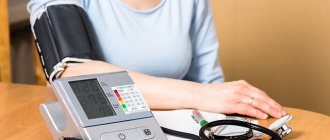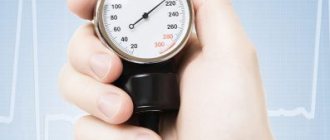Which device should you choose?
There is a wide range of mechanical, automatic and semi-automatic models on the market. Now we will figure out which one is more accurate and reliable.
The first pressure meters appeared in 1881 in Austria, and they worked on the basis of a mercury manometer. Over time, it was equipped with a cuff, and a Russian surgeon named Korotkov began taking measurements, listening to diastolic and systolic tones.
Mechanical blood pressure monitors were eventually replaced by semi-automatic ones, which automatically calculated only blood pressure readings. Fully automatic machines appeared in South Korea and Japan much later. Many people who are determining which blood pressure monitor is best for older or younger people mistakenly choose the latest models. They are confident that modern instruments are the most accurate and reliable, but this is not entirely true.
Which tonometer is more accurate - automatic or semi-automatic? There is no fundamental difference in the quality of measurements between them. Automatic models appeared in the late 90s. They are easy to use and have a large number of additional functions. To measure blood pressure, simply put on the cuff and press a button.
The built-in motor will pump the air to the desired level, and then the electronics will calculate the pulse and pressure limits, after which the information will be displayed on the display. There are two types of such tonometers and allow you to measure pressure on the wrist, finger or shoulder.
The least accurate automatic blood pressure monitor is the one that measures pressure on the finger. They work especially poorly when checking blood pressure in older people, so it is better to avoid such devices.
Like automatic ones, they calculate blood pressure and pulse themselves, and the user only needs to manually inflate the cuff with air using a bulb. Thus, a semi-automatic device is as accurate as a full automatic device.
Semi-automatic machines have fewer additional functions, but there is no urgent need for them. Also, such models are much cheaper than automatic ones and their batteries run out less often. According to hypertensive patients who are forced to measure their blood pressure themselves at home, semi-automatic tonometers are optimal. They are accurate and easy to use.
Such tonometers are also called sphygmomanometers. They consist of a cuff for inflation. Pressure gauge and rubber bulb with valve. Blood pressure is determined using a phonendoscope, which listens to the characteristic sounds of heartbeats.
In general, mechanical tonometers are more accurate than automatic ones, but only if they are used by professionals. It is difficult, and sometimes impossible, for an elderly person to measure their blood pressure on their own without outside help. At the same time, doctors most often use mechanical devices.
Which tonometer is the most accurate?
If we think objectively, the most accurate device is a mercury tonometer. By definition, pressure is usually measured in mmHg. Art. Such devices are not sold in regular pharmacies. They are large in size and are not without the disadvantages of mechanical devices.
It is almost impossible to measure pressure yourself with a mercury device, since this requires good hearing, vision and experience. Moreover, these units require regular calibration every six months.
As for automatic devices, they have a certain error, but it is not critical. Statistics show that the accuracy of tonometers greatly depends on the manufacturer:
- the error is about 5% for AND devices;
- approximately 7% for Omron;
- up to 10% for Microlife and Hartmann tonometers.
Mistake #3. Incorrect body position
To accurately determine blood pressure, it is necessary to eliminate the influence of gravity as much as possible. Traditionally, it is customary to measure blood pressure at the level of the heart. At the same time, the vertical position of the body provides the most accurate indicators. Lying on your side or other positions create additional interference.
You can place the patient on his back, but in this case the limb should be at the level of the heart. In addition, the indicators increase by 3-5 mmHg. If the cuff is higher than the heart, blood pressure readings will be underestimated. If it is lower, on the contrary, it is overpriced. The error can be quite significant: every 2-3 cm up or down from the level of the heart gives, respectively, minus or plus 2 mm Hg. Art.
Cardiologists talk about the so-called phlebostatic axis, passing approximately through the point of connection of the fourth rib with the sternum - at this level the middle of the right atrium chamber is located. This is what you should focus on as the “heart level” when measuring blood pressure. Doctors point out that in people with kyphosis or chronic obstructive pulmonary disease (COPD), this axis may be displaced, so self-measurement of pressure in such patients may lead to erroneous readings.
So, the correct position is: sitting on a chair with a back, your hand rests freely on the table with support at the elbow. During the measurement, you cannot move your hand, you cannot even speak.
How accurate are automatic devices?
As mentioned, every automatic blood pressure monitor has an error. Conscientious manufacturers indicate it on the packaging. Deviations are normal and do not indicate low quality of the tonometer if it does not exceed 10%.
The accuracy of electronic tonometers when measuring blood pressure is affected by compliance with the manufacturer's recommendations. Each certified device has instructions describing the procedure. The position of the cuff on the arm and the position of the limb (approximately at the level of the heart) are especially important.
Mechanical blood pressure monitors
The mechanical tonometer kit includes an analog pressure gauge with a pointer, an elastic cuff and a pressure pump connected by tubes.
A stethoscope is also included, which in some models is built into the cuff. Blood pressure is measured using a mechanical tonometer using the classical Korotkoff method. It is based on listening to the characteristic noises in the arteries that occur in the vessels after they are compressed. These sounds are called “Korotkoff sounds.”
Korotkoff sounds are listened to using a stethoscope.
When measuring blood pressure, a cuff is placed on the upper arm, the forearm is placed on a flat surface, and the head of the stethoscope is placed in the cubital fossa above the artery. The pump manually inflates the pressure in the cuff. When it becomes higher than arterial, blood flow in the compressed vessels will stop, and there will be silence in the stethoscope.
The air is then slowly released from the cuff. When the pressure in the cuff equals the systolic pressure, the first Korotkoff sound is heard. The pressure gauge reading at this moment is the systolic pressure. As the cuff deflates, the sounds change, successively changing five phases. The doctor is able to judge the patient’s health by these tones. The sounds disappear when the cuff pressure reaches diastolic blood pressure.
Arterial refers to the pressure that blood exerts on the walls of the arteries. At the moment of contraction of the ventricles of the heart, systolic blood pressure is noted, and at the moment of relaxation of the heart muscle, diastolic blood pressure is noted.
Advantages:
- provide high measurement accuracy;
- inexpensive,
- No power required for operation.
Flaws:
- require certain skills, especially when measuring blood pressure yourself;
- the person measuring needs good hearing and silence;
- it is necessary to manually inflate the pressure in the cuff. This may not be easy if the person is elderly or frail;
- When measuring your blood pressure, work with a bulb to slightly increase your blood pressure.
By the way, the reference devices are still mercury tonometers, which are almost never used in ordinary practice today. Although you can also find and buy them. But it’s hardly necessary - they are bulky and inconvenient.
How to check the accuracy of the tonometer?
We have almost figured out which tonometer measures blood pressure more accurately, but it is interesting to know how to check these devices. To determine how accurate your device is, you can run parallel diagnostics. In this case, you need to compare the measurement results with a reference device that has been calibrated in the factory. Of course, not every person has the opportunity to find such a device.
The tonometer can be attributed to the masters who repair such equipment. Professionals have a special setting that simulates pulse and blood pressure, which are set manually. After diagnosis, the readings calculated by the tonometer are compared with the established ones.
Correct blood pressure measurement
To obtain correct measurements, you must strictly follow some rules:
- To measure blood pressure, put the cuff that comes with a tonometer on your arm. It is placed on the arm 2 cm above the elbow. If it is located higher, the readings will be higher than the true ones, and if it is located lower, the device will show lower numbers.
- The cuff is adjusted to size and should not hang loosely on the arm or squeeze it. If the cuff itself is too narrow, such a device is not suitable.
- After placing the cuff, air is inflated with a rubber chamber (bulb) if the device is mechanical or semi-automatic.
- After gradual deflation of air, blood pressure readings are determined.
How to avoid false results
Sometimes the device gives incorrect readings, so you need to constantly check its serviceability. But to do this, you still need to know what types of tonometers exist. Pharmacies sell the following blood pressure monitoring devices:
- Mechanical. They are difficult to measure blood pressure. This can only be done by a person who has good hearing and is able to accurately determine the moments of the pulse with a phonendoscope and record the indicators corresponding to this moment.
- Semi-automatic devices. They are similar to automatic devices. Only air is pumped into the bulb manually.
- Electronic or automatic are among the most modern devices. Anyone can use such devices.
When used correctly, any device will show accurate results. But it is possible that errors may also appear. Electronic blood pressure monitors malfunction when the batteries are low. Errors can also be caused by a malfunction of any part of the device: a bulb with a cuff, a hose through which air is pumped into the cuff, or an electronic mechanism.
What determines the accuracy of a tonometer?
Cuff fixation
The cuff must be put on in accordance with all the rules provided in the tonometer user manual. If this is not done, then at best the tonometer (automatic or semi-automatic) will produce a measurement error, and at worst – incorrect results, on the basis of which an incorrect idea of the current state of health will be formed. The cuff should be located 1-2 cm above the ulnar fossa and fit snugly to the skin.
Cuff size
The cuff must strictly fit in size, otherwise, if the cuff is small, the pressure measurement result will be overestimated, and if the size is too large, it will be underestimated. The width of the cuff should be 40% of the arm circumference.
The user manual, which is included with the tonometer, shows the rules for measuring blood pressure. It is necessary to STRICTLY follow all the listed recommendations, as well as adhere to the basic tips when preparing for blood pressure measurement:
- No smoking for 30 minutes;
- Do not drink coffee, strong tea and alcoholic beverages;
- Rest 15-20 minutes before measuring.
Battery charge
Automatic and semi-automatic blood pressure monitors are powered by batteries, and some models have an adapter for mains operation. If the batteries are low, the tonometer may give an incorrect measurement result.
If any malfunctions are noticed, it is recommended to immediately contact the service center. Under no circumstances should you repair the tonometer yourself, especially if it is under warranty.
Device setup
You can check the tonometer for accuracy at a pharmacy. This check is carried out using a reference device. If any faults are detected at the time of purchase, you can return the device and replace it with a working one. There is also a special monitoring installation that is used to check the accuracy of the device. But it is expensive, so not everyone can afford to buy it for home setup of the device. You can also contact a workshop where it is possible to check the tonometer for accuracy and carry out repairs if necessary.
You can also connect two devices to the cuff at the same time. If one of these devices is adjusted accurately, then such a check of the tonometer is possible at home.
How can I check the device?
Nowadays electronic devices are the most popular because they have an affordable price. They do not require special skills from the user to measure blood pressure. Even older people, women and teenagers can cope with it. They are easy to turn on and off once the test is complete.
But measurement accuracy plays a major role. Electronic and automatic devices often malfunction. For this reason, constant checking of the tonometer is necessary to avoid mistakes.
If your friends or neighbors have another device whose accuracy has been verified, you can use it to control accuracy and settings. The second such device will help you check the accuracy of your tonometer readings and identify errors in measurements.
Some are of the opinion that it is better to carry out measurements with mechanical instruments. But modern automatic devices perform their tasks perfectly. Some of the high-quality tonometers are devices from Omron.
The parallel connection method helps to evaluate each of the two devices and check the tonometers for accuracy.
For proper verification, follow the following algorithm:
- devices are connected in parallel for simultaneous measurements;
- double testing is carried out for objective assessment, control tests;
- If necessary, check individual parts of the device.
How to determine pressure without a special device
Read on and find out how to measure blood pressure if you don’t have an automatic medical device at hand. The methods described below for measuring blood pressure using improvised means will help you out every day, helping you avoid critical situations. After studying each one, you can choose the most convenient one. Take into account the recommendations of specialists to be able to record changes in blood pressure levels and take appropriate medications in a timely manner.
The question of which hand to measure pressure on is worthy of special attention. Many people think that there is no difference, but this opinion is wrong. Modern medicine claims that even the slightest difference in blood pressure levels on the left and right arm may indicate that a person is at risk of developing serious diseases associated with blood vessels. A difference of several units can lead to irreparable consequences. Regardless of which way you prefer to measure blood pressure, you should always check both hands.
By pulse
A simple and yet effective technique that has become widespread throughout the world. If you know how to measure blood pressure using your pulse, you won’t need any special medical devices at all. The main thing is to learn how to correctly time and correctly perform basic mathematical calculations. So, let's find out how to measure blood pressure without a tonometer, using your pulse as a guide.
- Take a comfortable position on a chair at the table.
- Place a mechanical or electronic wristwatch next to you.
- Imagine something pleasant for 2-3 minutes to calm your nervous system.
- Gently place the fingers of your left hand on your right wrist. Make sure that the cuffs of clothing do not pinch the blood vessels.
- Count the number of beats in a 30-second time interval.
- Multiply the result by two to get the number of beats per minute.
A value of 60 indicates that blood pressure is low. Normal values lie within the range of 60-80 beats per minute. If, as a result of calculating the pulse, the result is a value exceeding 80, it means that the pressure is increased. To cast aside doubts about the correctness of the measurements, perform the algorithm of actions again.
Using thread, ruler and pendulum
It will be useful for people who have difficulty feeling the pulse in their hand to know how to measure pressure without a device, using an ordinary ruler, sewing thread and a metal pendulum. The role of the latter can be played by a gold/silver ring, a tailor's needle or an ordinary metal nut. If this is relevant to you, then write down how to measure blood pressure without a tonometer.
- Attach a ruler 20-25 cm long (no more) to your hand, from the wrist to the inside of the elbow. The zero should be on the hand side.
- On a thin sewing thread 50-60 cm long, place the item you have chosen as a beacon. Take the thread by the edges. A manual pressure gauge for measuring blood pressure at home is ready.
- Slowly bring the beacon suspended on a thread to the ruler and move it along the scale from zero towards the extreme mark. The closer the load is to the ruler, the more accurate the blood pressure measurement result will be.
- When the beacon moves a few centimeters, you will notice that it begins to oscillate from left to right. Note the mark on the scale and multiply its value by 10. This is your lower blood pressure reading.
- We continue measuring blood pressure. Continue the thread. The second time the beacon will begin to fluctuate at the upper blood pressure level.
Arteries and pressure measurement methods
A device that measures a person's blood pressure is called a tonometer.
Today, in specialized medical stores you can find automatic, semi-automatic, wrist and mechanical devices.
A mechanical device used to measure a person’s blood pressure is considered the most common in the medical field. The operation of the tonometer is based on the Korotkoff method.
Such a device has high measurement accuracy, but to obtain the desired results you need to have certain skills, without which it is very difficult to obtain the correct pressure.
- During measurement, you must wear the cuff correctly.
- It is important that the phonendoscope is evenly fixed when measuring blood pressure.
- The cuff is manually inflated with air.
- The regulator is released smoothly.
- The scale of the device indicates when the tones begin and end.
Since when measuring pressure you need to hear the first and last tone in time, when using a mechanical tonometer it is important to have good hearing. Therefore, most often this procedure is carried out by experienced doctors or young people who know how to properly handle the device.
Many doctors in their practice use a mechanical device when they need to measure blood pressure, since this tonometer provides accurate research results.
If you plan to carry out the procedure at home, it is recommended to purchase a model in which a phonendoscope is mounted. Also, such a device has a fairly low cost compared to other options.
During the purchase, you need to check the strength and reliability of the metal case and test the measuring scale. It is desirable that the scale have large and clear divisions. Models with night lighting will be very convenient for use in the evening and at night. However, the main thing is to know how to measure blood pressure correctly.
The push-button regulator compresses the air more evenly. When buying a device for measuring blood pressure from a person, you should pay special attention to the manufacturer.
Electronic blood pressure meters are considered more convenient for use at home, since the procedure can be carried out without any outside help. This is the main advantage of this device.
An electronic tonometer is a device with a display that displays upper, lower pressure readings and pulse. The main unit has a cuff attached.
Operation of the electronic tonometer is very simple:
- The cuff is placed on the arm just above the elbow bend according to the instructions, after which the “Start” button is pressed.
- Using a compressor, air is pumped into the cuff.
- After receiving the signal, the necessary indicators are recorded.
Modern models of electronic tonometers can store measurements in memory, and the device also has a special indicator of high blood pressure and arrhythmia. This is very convenient for those people who monitor indicators.
The only disadvantage of such a device is the fact that the person must place his hand correctly during the procedure, otherwise the results will be incorrect. The hand is placed on the opposite shoulder, palm down. The second free hand presses the start button and then supports the elbow while the measurement is taken.
Semi-automatic devices are practically no different from electronic devices, except that air is pumped into the cuff manually. Such blood pressure monitors measure not only a person’s blood pressure, but also their pulse.
The device has a main device with a display, a cuff and a bulb. The cuff is placed on the forearm at a distance of 3 cm from the elbow. By pressing the bulb, air is pumped into the cuff to the desired level. After this, the tonometer independently conducts the study and displays the measurement result on the screen.
This device, called a wrist device, is worn on the hand, which is why young people prefer to use it.
The fact is that at an older age, the vessels on the wrist undergo age-related changes, which directly affect the accuracy of the data obtained, so older people usually do not use such a device.
Unlike other devices, a wrist tonometer has numerous advantages:
- The modern device is convenient to use;
- The device has a compact size;
- You can measure a person’s blood pressure at any time, regardless of the time of day or situation.
This device is convenient to use at home; it is also often chosen by people with low vision and hearing. Additionally, in specialized stores you can find models that are worn on the finger.
Tonometer options
Nowadays, manufacturers offer a wide variety of device models:
- Tonometers can have a multi-line display on which the results of the study are displayed.
- Some models have a voice function for reading data.
- Most models have a special backlight for the display.
- The latest versions of the models are able to store several results from studies of several people.
- More expensive models have a USB output for connecting to a personal computer and offer all methods of measuring blood pressure.
Manufacturers of new models provide that the devices can operate on mains power or batteries.
If a person has tachycardia, doctors recommend purchasing a device that can independently select a formula for calculating the obtained data. Such a device will take measurements several times and then display the average value of the indicators. This is necessary when it is necessary to monitor blood pressure in cardiac patients.
For the first time in the history of mankind, blood pressure (BP) was measured by Stephen Gales in 1714. The experimental animal was a horse, into whose carotid artery the researcher inserted a vertical brass tube and looked at the height to which the blood column rose. Over the next 200 years, a whole galaxy of scientists came up with different ways to measure pressure and created various devices, until, finally, in 1905, our compatriot, military surgeon N.S.
The essence of the Korotkov method is as follows: a cuff (Riva-Rocci sleeve, named after its inventor) is put on the patient’s shoulder and air is pumped into it. The air pressure in the cuff is monitored by a pressure gauge, which the doctor carefully looks at. In this case, the stethoscope (or phonendoscope in later versions) is placed on the projection of the brachial artery in the fossa of the elbow. What happens?
- Air is pumped into the cuff until the pressure in it is higher than the person's systolic pressure. This moment is easy to determine: the doctor stops hearing any sounds. The blood flow is completely blocked.
- Next, the doctor begins to gradually deflate the air from the cuff, and the pressure in it drops. As soon as it becomes equal to the person’s systolic pressure, the doctor hears the so-called first Korotkoff sound. At the moment of systole, the pressure in the brachial artery increases, and the blood rushes through the vessels of the shoulder. Therefore, sounds and noises are uneven.
- The doctor continues to bleed the air, the pressure in the cuff drops even lower, the sound in the phonendoscope becomes muffled - and disappears completely. At this moment, the diastolic pressure is recorded. As soon as the pressure in the cuff drops below this value, it means that there are no longer any obstacles to blood flow.
Mechanical blood pressure monitors are inconvenient because a person must have certain skills to use them. As a result, the human factor plays too large a role when measuring pressure using the Korotkoff method.
That is why electronic tonometers, which are based on the oscillometric method of measuring blood pressure, have gained such popularity. The essence of the method is to record changes in tissue volume during arterial pulsation depending on the dosed pressure exerted on the limb. That is, the equipment reads changes in pressure in the cuff that are invisible to the eye.
This technique was first proposed by the physiologist E. Marey in 1876. At that time, it was too complex. Today, humanity has acquired computers and analytical programs that allow them to calculate data of any size. We also add that, unlike tonometers using the Korotkoff method, electronic tonometers allow you to apply a cuff even to a thin layer of tissue. The error of modern electronic tonometers does not exceed 3 mm Hg. Art.
True, when used at home, the influence of the human factor still cannot be avoided. What mistakes do ordinary patients make when they want to measure their blood pressure on their own?
To a large extent, a person’s blood pressure depends on what he did before the measurement. Therefore, a number of rules that take into account the patient’s psychology should be strictly observed:
- It takes 5-10 minutes for a person to adapt to the doctor’s office. “White coat syndrome” is one of the main problems in measuring blood pressure in regular clinics. Hidden fear of doctors is reflected in elevated blood pressure levels.
- An attempt to measure pressure immediately after coming from the street or in a state of excitement adds from 20 to 40 mm Hg. Art.
- Conversations during measurements can add another 10 mm Hg. Art.
- The last cigarette before measuring blood pressure should be smoked at least 1.5-2 hours before.
- You should not eat food at least an hour before the procedure, and two hours is the minimum period after consuming alcohol or tonic drinks.
- After taking eye and nasal drops, 1.5-2 hours should also pass.
Is it possible to measure blood pressure without a tonometer?
The answer is clear: yes, it is possible. Having a set of familiar household items on hand and knowing a simple sequence of actions, you can determine your blood pressure with sufficient accuracy. Remember or write down simple techniques for measuring blood pressure at home so that acute manifestations of hypertension do not take you by surprise.
Signs of high blood pressure
If you decide to master the skill of independently measuring blood pressure, you should first find out how deviations from the norm manifest themselves. It is almost impossible to feel an increase in blood pressure with your body alone. To catch this moment, you need to be observant. The following signs may indicate that blood pressure is exceeded:
- nausea;
- causeless feeling of anxiety;
- dizziness;
- headache;
- rapid pulse;
- heart rhythm disturbance;
- minute darkening in the eyes;
- increased body temperature;
- facial redness;
- increased sweating;
- shortness of breath;
- swelling.
Signs of low blood pressure
Along with high blood pressure, there is the opposite problem, and it is called hypotension. In its specificity, this disease is no less dangerous. Low blood pressure often causes loss of consciousness. If you have been diagnosed with this disease, then learn to identify its manifestations based on your condition. Below is a list of signs indicating low blood pressure:
- drowsy state;
- feeling of weakness in the muscles;
- pain in the back of the head;
- attention deficit;
- nausea;
- weak pulse;
- deterioration in coordination of movements;
- feeling of lack of air.
What type of blood pressure monitor is the most accurate?
According to doctors, the most accurate tonometers are mercury models. They measure blood pressure in millimeters of mercury. It is almost impossible to find such specimens in pharmacies today. This is because they are inconvenient due to their size and have a lot of disadvantages. In addition, not every person is able to measure blood pressure using a hand-held device. This requires certain skills.
Another difficulty in using a mechanical tonometer is the need for regular adjustments in a specialized center.
Automatic devices are currently more popular. However, they do not always give a reliable result of measuring blood pressure. Often the error of such models is about 5 mmHg. Art. Therefore they are considered less accurate.
Mercury tonometers are the most accurate, but inconvenient to use
What types of pressure meters are there?
They are divided into two groups: mechanical and electronic. Latest on: automatic, semi-automatic.
The advantages of a mechanical tonometer are:
The disadvantage of mechanical meters is the need for professionalism of the measuring person involved in the measurement stages.
The advantages of a semi-automatic machine will be:
- a person without experience can cope;
— measuring pulse and pressure simultaneously;
- no phonendoscope needed;
— modern models of tonometers are equipped with an arrhythmia indicator;
— measurement results screen.
The disadvantages of a semi-automatic machine will be:
— some models have age restrictions.
When choosing a device for measuring blood pressure, the main thing is accuracy, correctness, and accurate and high-quality tonometers are a necessity in every home.
The main thing for the accuracy of the tonometer reading is correct use (following the operating rules). If done correctly, the error of automatic tonometers is +/- 3 mm. rt. Art.
Sometimes people complain specifically about underestimated readings from electronic meters.
Let's look at why blood pressure monitors underestimate the result. After all, an underestimated result ultimately leads to incorrect actions.
How to determine blood pressure without a tonometer - best methods
The question of how to determine pressure without a tonometer is relevant for those who do not have a special device at hand, and the symptoms of the body are very alarming. It is necessary to know information about blood pressure in order to take the necessary measures in time. Indeed, with different indicators, first aid differs significantly. Without a tonometer, it is impossible to determine the exact values of upper and lower pressure, but you can find out whether it has decreased or increased. After all, before the invention of this device, people also knew about pathologies of this kind and diagnosed them using other methods.
- Determination of blood pressure by pulse
- Localization of headache
- Diagnosis by symptoms
- Measuring method with ruler and pendulum
Setting up a tonometer at home
There are several tips on how to test the mechanism for serviceability at home. There is a special installation that shows a certain pulse and breathing of a person, which it simulates. The tonometer is calibrated according to these data. But such an installation is very expensive and not everyone can afford it at home. The second way is to connect two blood pressure monitors to one cuff, one of which will be precisely adjusted by a medical equipment specialist.
The reference tonometer can be set up in a pharmacy, after which you can calibrate your equipment using this data
An accurate device is necessary in the house, because its indicators can help to draw attention to the problem in time. It is necessary to check the equipment for malfunctions, and also always observe the correctness of the correct pressure measurement
Checking the pressure measuring device for accuracy
This device is designed to monitor blood pressure. For normal operation of the device, it is necessary to check it and configure it correctly. Such a device is necessary to have in the apartment not only for people suffering from hypertension. Every person needs a device with which to control blood pressure, since a person constantly has to deal with negative factors that cause its fluctuations. After all, even in absolutely healthy people there are often cases when the balance of blood pressure is disturbed. There are many affordable and accurate devices on the market to measure this indicator. They generally give accurate measurement results, but sometimes they fail
For this reason, it is important to know how to check your blood pressure monitor. If there is any doubt about the correctness of the device’s readings, and there is no way to check it yourself, you need to know where to check the tonometer for accuracy.
Let's try to figure it all out.
To obtain correct measurements, you must strictly follow some rules:
- To measure blood pressure, put the cuff that comes with a tonometer on your arm. It is placed on the arm 2 cm above the elbow. If it is located higher, the readings will be higher than the true ones, and if it is located lower, the device will show lower numbers.
- The cuff is adjusted to size and should not hang loosely on the arm or squeeze it. If the cuff itself is too narrow, such a device is not suitable.
- After placing the cuff, air is inflated with a rubber chamber (bulb) if the device is mechanical or semi-automatic.
- After gradual deflation of air, blood pressure readings are determined.
How to avoid false results
Sometimes the device gives incorrect readings, so you need to constantly check its serviceability. But to do this, you still need to know what types of tonometers exist. Pharmacies sell the following blood pressure monitoring devices:
- Mechanical. They are difficult to measure blood pressure. This can only be done by a person who has good hearing and is able to accurately determine the moments of the pulse with a phonendoscope and record the indicators corresponding to this moment.
- Semi-automatic devices. They are similar to automatic devices. Only air is pumped into the bulb manually.
- Electronic or automatic are among the most modern devices. Anyone can use such devices.
When used correctly, any device will show accurate results. But it is possible that errors may also appear. Electronic blood pressure monitors malfunction when the batteries are low. Errors can also be caused by a malfunction of any part of the device: a bulb with a cuff, a hose through which air is pumped into the cuff, or an electronic mechanism.
What is the error of an electronic tonometer?
Tonometer
– this is the name of the device for measuring blood pressure.
We live in the era of electronics, and it is natural that more and more people who, when choosing a blood pressure monitor, prefer electronic modifications. They believe that electronic ones “by definition” are better, more accurate, and more reliable than “antediluvian” mechanical ones. Is it so? Or is this always the case? Let's figure it out.
Let's start with the fact that Rostest-Moscow never ceases to receive requests from consumers to explain how it can be that the same electronic tonometer (an expensive and well-known brand) can perfectly accurately measure blood pressure, for example, to a wife and, surprisingly, mercilessly “lie” when measuring your husband’s blood pressure?!
And everyone is wondering: why do doctors, even in good clinics, continue to use obsolete mechanics and not switch to advanced electronics?!
ELECTRONIC TONOMETERS LYING? AND IS THERE SUCH “THE BEST ELECTRONIC TONOMETER”?
At first glance, electronic blood pressure monitors are truly beyond competition. Many people are not able to independently measure their blood pressure with a mechanical tonometer, and this vital procedure becomes a problem for lonely people, those who have no one to constantly turn to for help. But often you have to measure your blood pressure several times a day! Add to this the fact that the accuracy of taking blood pressure (BP) measurements depends on the visual acuity and hearing of the person taking the measurements, which older people, as a rule, cannot boast of.
An electronic tonometer is much more comfortable and easier to operate without the need for outside help. Plus, human errors are eliminated. It is also important that previous results are stored in the device’s memory, this allows you to track the dynamics.
It is not surprising that more and more people want to acquire an electronic blood pressure monitor. And there are plenty of these on sale today. So why doesn’t “antediluvian” mechanics become a thing of the past? And what are the reasons for patients’ complaints about advanced electronics? According to the order of the Ministry of Health of the Russian Federation dated January 24, 2003 No. 4, the main method of measuring blood pressure is the N.S. method. Korotkoff (Korotkoff sounds) – a mechanical dial tonometer with a phonendoscope. The same one that many consumers today consider outdated and outdated! Why?
Measuring blood pressure by other methods, primarily oscillometric (using automatic devices), in 5-15% of cases gives blood pressure values that are consistently and significantly different from the values using the Korotkoff method. This is due to the discrepancy between the characteristics and state of the cardiovascular system of a particular person and the algorithm for processing measurement results that is installed in the device used.
The fact is that it is not possible to develop a universal algorithm for processing measurement results that is equally suitable for all categories of users. Manufacturers install various algorithms on their electronic blood pressure monitors. Before going on sale, electronic tonometers in each case undergo clinical trials in specialized medical institutions on a large group of patients of different ages. The error in measuring blood pressure with a device of a specific model is determined during these tests by comparing its readings with blood pressure readings obtained using the “Korotkoff method”. Only with positive results of clinical trials for a sufficiently large group of users does the electronic tonometer receive a certificate of conformity and is approved for use. This means that the device is quite likely to be suitable, I emphasize, for a fairly large group of users, but... not for everyone and not for everyone!
So there are no universal devices “for everyone”, and you can hardly count on their appearance in the near future. Therefore, if you intend to buy an electronic tonometer, do not repeat the common mistake of trusting the advice of “experienced” users who claim from their own experience: they say, this one is good, but this one is no good. The most reputable brand of electronic blood pressure monitor that is suitable for them may very well not be suitable for you.
HOW TO CHOOSE AN ELECTRONIC TONOMETER
An electronic tonometer needs to be selected individually, for yourself. Like glasses. The older a person is and the more problems he has with the cardiovascular system, the more difficult it is to choose a device. And it’s not about the quality of the device, not about the manufacturer or the price. The simplest device may be ideal, but the most expensive one, which seems to “suit everyone”, may not! For certain categories of patients, “automated machines” are generally unacceptable.
The selection of the device must be done by “trying it on” by comparing its readings with blood pressure readings obtained by a mechanical dial tonometer with a phonendoscope using the “Korotkoff sounds” method. And only after confirming a high degree of agreement between the readings of both devices in a series of control measurements can you use the automatic blood pressure meter of this model with sufficient confidence.
ERROR OF ELECTRONIC TONOMETER
Sometimes consumers conclude that the electronic tonometer they purchased is defective, on the grounds that the “real” error of the electronic tonometer is supposedly much greater than what is indicated in the instruction manual. But the fact is that the pressure measurement error (less than 3 mm Hg) given by the manufacturers in the device’s instruction manual, which is mistakenly taken by users as an error in blood pressure measurement, is actually an error in measuring the air pressure in the cuff.*
The error of an electronic tonometer (measuring blood pressure with a specific device in a specific person) must be determined in the manner described above. Comparison of its readings with blood pressure readings obtained by a mechanical dial tonometer with a phonendoscope using the “Korotkoff sounds” method. And don’t hesitate to take a “reference” mechanical tonometer that you trust with you to the pharmacy from home, or ask the staff for one.
In our opinion, sellers of blood pressure meters are obliged to draw the attention of the consumer to all of the specified features of the selection of automatic blood pressure meters when purchasing and using them. But they don't always do this. The absence of such information when purchasing a device may mislead the buyer.
How to check a blood pressure monitor at home
The version with a reference tonometer is also suitable for home use. If you or someone you know has another device that you are confident is accurate, use it for comparison. It will help to identify not only gross deviations from the norm, but also small errors.
Some people, especially older people with extensive experience in measuring blood pressure, often believe that mechanical tonometers are better and more accurate. However, this is not the case, because modern electronic devices do their job very well. The parallel measurement method (using another tonometer) makes it possible to evaluate the quality of each device.
To avoid mistakes, you need to follow certain instructions:
- The instruments are connected in parallel so that measurements occur simultaneously.
- Several test measurements are carried out to obtain an objective assessment.
- If necessary, individual elements of each device are checked.
The design of a simple mechanical tonometer consists of a bulb, a pressure gauge and a shoulder cuff. They are connected together into a single system, the pressure in which is always the same. The mechanical device can be used as a reference for parallel measurements.
You need to do this as follows:
- The pear is unscrewed.
- An electronic tonometer is connected to the tube through a special adapter.
- The procedure for pressurizing and further measurement is started.
There is no particular difficulty in this, you only need an adapter. The design of the medical device allows you to easily unscrew individual elements without any complications.
This option is interesting because information is obtained in two ways at once:
- On the screen of an electronic device.
- Using a regular phonendoscope.
A fairly experienced person is able to count the pulse rate by ear, so he sees deviations and errors in the indicators of an electronic device.
Remember that the permissible error is no more than 3 mmHg. Deviations greater than this value no longer correspond to the norm, so calibration of the device is required.
If there are deviations, check the correct connection of all elements, the reliability and uniformity of fixation of the cuff. If this does not help, then contact the service center for an accurate check and adjustment of the tonometers. You should not use a device that gives incorrect readings, even if the deviations are not too significant at first glance.
Correct use of electronic blood pressure monitors
Electronic devices are popular because they are relatively inexpensive and do not require special skills and knowledge from a person. Even older people can easily handle it with simple instructions:
- The device turns on.
- The cuff is attached to the shoulder.
- The “Start” button is pressed.
- The end of measurements is expected with information displayed on a small screen.
However, correct measurements are key. Unfortunately, electronic devices often malfunction. Regular checking of tonometers will allow you to avoid this and obtain accurate data on blood pressure levels.
First of all, it is important to use the device itself correctly to avoid data distortion:
- Place the cuff on your arm correctly.
- Remain calm during the measuring process.
- Monitor the battery level of your electronic devices.
Stress, physical activity, alcohol and even a cup of strong coffee can increase or decrease blood pressure. If there are distortions in the normal state, then you should figure out how to check the tonometer.
Setting up tonometers for work
Specialists in medical institutions check devices using a professional installation that simulates a certain pulse and pressure. The tonometer is calibrated according to specific indicators, so doctors evaluate the quality of each specific tonometer. This requires the right to verify measuring instruments used to treat patients. Unfortunately, this option is not suitable at home.
What should ordinary people who do not work in clinics and hospitals do?
Tonometer calibration is a service that is offered in many pharmacies, especially those specializing in the sale of medical equipment. Specialists will carry out the setup and set the correct indicators. For this purpose, a reference device is used for comparison for accuracy.
How to measure blood pressure with a mechanical tonometer and stethoscope
Although a manual blood pressure monitor is not as easy to use as automatic models, it provides the most accurate results. Therefore, if you have arrhythmia, it won’t hurt you to master this hand-held device; you just need to follow certain rules.
Rules for measuring blood pressure with a mechanical tonometer:
- Immediately before measuring your blood pressure, you should sit and rest for about 10 minutes.
- Then, while in a sitting position, you need to apply the cuff 5 cm above the elbow area.
- During measurements, the hand should be relaxed.
- Place the stethoscope under the cuff - ideally, if you find the pulse in the elbow bend, this is where you can place it on the skin.
- Pump the air with a pear to the 180-220 mm mark. rt. Art. or more if you are sure that your blood pressure will be higher. Determine the mark based on an indicator that is 40 units higher than the one you expect.
- Then gradually, slowly deflate and listen to the sounds in the stethoscope.
- When you hear the first blows, remember the readings. This will be the result of the upper pressure - systolic. When you stop hearing beats, you will need to record another number - this will be the result of the lower diastolic pressure.
As you can see, using such a device is easy, you just need to practice, and you will feel like a nurse.
Of course, an automatic tonometer, in which an electronic screen shows the measurement results, and the cuff takes in air and contracts on its own, is even easier to use. But it is the mechanical device that shows the most accurate results, does not require battery replacement, and works almost flawlessly.
Why does the blood pressure monitor lie, or is accuracy the politeness of kings?
“Please help me understand the situation! — a letter to the editor of “Web Journalist” arrived the other day. — My mother is already 79 years old. Her blood pressure often “jumps.” I have been thinking about buying an electronic blood pressure monitor for a long time. Last week I finally decided. So what would you think? The first impression is that the thing is stylish, comfortable and very necessary. But... The tonometer is shamelessly “lying”! As soon as the cuff was placed on the mother's wrist, he showed 178/135. Horror! Everyone at home was seriously alarmed. I had to call an ambulance...
The doctors arrived, took out a regular tonometer with a bulb, and put a cuff on my shoulder. The pressure turned out to be… 125/90! They measured him again, and again... Everything was normal! Why, then, the readings of an electronic device (by the way, produced by a well-known Japanese one? The doctor just threw up his hands... The next day I went to the pharmacy to exchange the device. But they assured me that everything was in order. They say that we carried out the measurements incorrectly. Strange ... Tell me what to do in such a situation? And is there a special service in Minsk that would check the accuracy of tonometers?.."
The question is, of course, interesting... And very relevant! Today, about 15-20 models of tonometers of various types are sold in shops and pharmacies in Minsk. These are not only traditional “pears” with a phonendoscope and a dial gauge. In recent years, imported “automatic machines” have come into fashion. They are produced by AND, Microlife, Marshall, Nissei, Omron, etc. The measurement process, at first glance, will not cause any particular problems. Just press a button and the tonometer will do everything itself and display the result on the LCD display. Comfortable? Certainly! But it turns out that not everything is so simple!…
I have heard more than once that the spread of readings on imported “automatic machines” and “semi-automatic machines” is very large. Let's say that now the device shows 120/80, and after a few minutes - 135/95. How can this be? Unclear. Moreover, there is an opinion that devices that measure pressure on the wrist are not very accurate. But they are not cheap! Some hypertensive patients do not recognize imported electronic “toys” at all, preferring to measure blood pressure in the traditional way. Buyers' fears are unfounded. All electronic tonometers, regardless of manufacturer, model and design features, are highly accurate. Their error does not exceed plus/minus 3 mm Hg. Then what's the matter?!
There are several reasons why the readings on the tonometer display are incorrect. Firstly, their scatter occurs due to various interferences created by hand or body movements (for example, knocking on a table). Secondly, the sensitive sensor reacts to the slightest change in air pressure in the cuff (you can’t even talk during the measurement!). Thirdly, the emotional state of the patient is of great importance. Fourthly, you need to be able to apply the cuff correctly. Finally, the accuracy of the measurement in some cases is affected by the type of cuff itself...
Before purchasing a blood pressure monitor, consider the following. Devices that measure pressure on the wrist are not recommended for people over 50 years old (with age, blood vessels lose elasticity), as well as for overweight patients. The further down their arm the pressure is measured, the greater the likelihood of inaccuracies. This is due to unequal blood pressure in the arteries in the area of the elbow joint and wrist due to different distances from the heart, as well as variability in the diameter of the vessels.
In addition, during measurement it is very important to place the cuff exactly at the level of the heart. This is especially important when measuring blood pressure at the wrist. So, if the device is lower than the heart, the result will be overestimated. And one more important point. Many people measure their blood pressure several times in a row and then determine the average result. This is not entirely correct. The break between measurements should be at least 7-10 minutes. This allows the blood vessels to regain elasticity. Never measure blood pressure with your hand in the air. Do not put the cuff over the clothing or roll up the sleeve, otherwise the fabric will squeeze the skin, which will distort the result.
Correct selection of the cuff is another condition for accurate measurements. All of them are equipped with Velcro fasteners for fastening on the shoulder or wrist, and are made of synthetic materials. The average arm circumference of an adult in the shoulder area is from 23 to 32 cm. The width of the cuff should be about 40% of this value (about 12-14 cm). It is also necessary that the length of the cuff pneumatic chamber be at least 80% of the circumference of the limb (about 18-26 cm). Short and narrow cuffs can cause overestimation of readings.
Let's assume that you follow all the recommendations, but the tonometer is still lying. What should I do? If desired, it can be verified in a metrology laboratory. Tonometers used in hospitals and clinics must be calibrated annually. As for home blood pressure monitors, this must be done once every three to five years. The reason for incorrect readings on the device display lies either in the individual characteristics of the person (some people generally “cannot stand” automatic tonometers), or in the fact that you are taking the measurements incorrectly. Before purchasing a tonometer, check whether it has passed pre-sale metrological control of the accuracy of the readings.
How to check the accuracy of a home blood pressure monitor
Many users of blood pressure measuring devices may be interested in the accuracy of the readings obtained with their help. To find out, you need to check the tonometer for inaccurate readings. The easiest way to do this is by conducting parallel diagnostics.
There are several ways that explain how to check the accuracy of a measuring device at home or in specialized centers. If you wish, you can use one of them:
- A parallel check needs to be done. This method was mentioned above. To check, you need to attach a tonometer to the cuff, which may raise doubts about the correctness of the data on blood pressure and pulse. A reference device that has been factory calibrated is also installed. The cuff should be placed on the person and all necessary manipulations should be carried out to check the status of his blood pressure. The obtained values after diagnostics with a reference device will need to be compared with the data indicated on the second device;
- To assess the accuracy of blood pressure measurements using a specific tonometer, you can use a special installation. It is quite cumbersome and expensive. The device simulates a person’s pulse and blood pressure, the values of which are preset. Afterwards, the indicators obtained during the diagnosis are compared with the established ones;
- You can check the operation of the tonometer by measuring the correct functioning of the pressure gauge and the rate of air bleeding. For this purpose, a special device is also required.
Verification and calibration of tonometers
First, it’s worth understanding the difference between “verifying” and “checking” a tonometer.
Verification is a set of metrological operations to determine the accuracy of the device being tested. Tonometers for medical institutions should be checked once a year; for households, once every 3-5 years is sufficient. Verification of tonometers is carried out at regional centers for standardization, metrology and testing (TSM), where a special apparatus is used to carry out the procedure, simulating a person’s blood pressure and pulse. The device is given certain parameters, which are compared with the measurement results of the tonometer being tested. If the verification is successfully completed, a corresponding certificate is issued, otherwise the device is sent for re-verification or to a service center, where the tonometers are calibrated. Addresses of service centers are indicated in the user manual.
It should be noted that before submitting your device for verification and further adjustment, make sure that you are using it correctly. The fact is that in most cases, incorrect tonometer readings are associated with its improper operation.











